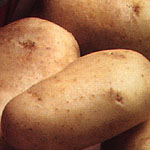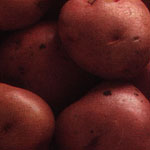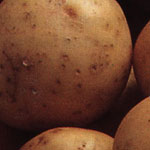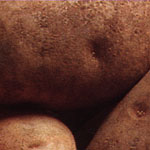

Round White / Russet


Finnish Yellow

FoodFood InformationVegetablesRoot Vegetables
The potato is a tuber that originated in South America. It reached Ireland
by way of Europe some two hundred years after it was first introduced to
the Old World by the returning Spanish explorers. Early in the eighteenth
century it was brought to the English colonies in North America by settlers
arriving from Ireland, which is why we call it an Irish potato.
Irish potatoes are not true potatoes, nor are they related to sweet potatoes.
The true potato is the yam. The sweet potato is botanically a member of
the morning glory family. The Irish potato is a member of the nightshade
family, which includes eggplants, peppers, and tomatoes.
Even though it is neither Irish nor a potato, this tuber is produced in
greater quantities throughout the world than any other fresh vegetable.
In North America it ranks number one in tonnage consumed. While there is
only one crop per year, potatoes are harvested in the spring, summer, and
fall and are available in ample supply year round. Those harvested in the
fall are put in storage, with a minimum of loss to shrinkage or decay, in
quantities sufficient to overlap the next year's crop. As a rule, potatoes
sell at moderate and even modest prices.
The freshly dug potatoes that go directly from the field to market
in the spring are called new potatoes. Those that are put into storage after
they are harvested in the fall are called old potatoes when they arrive
in market. The new potatoes have a somewhat different flavor and
texture than the old ones. The new potatoes have a fresher flavor and are
firmer and moister. While they don't fry or mash well and take forever to
bake, they are excellent when boiled. Traditionally, boiled new potatoes
are served with their jackets intact and garnished with a sprig of parsley.
These outer jackets of the new potatoes can be either white or red in color.
Even though both are similar in texture and flavor, most people prefer and
identify new potatoes by their red skins.
But note that not all red-skinned potatoes are new potatoes. Some red-skinned
potatoes are put in storage in the fall, and when they reach the market
in the winter and early spring they are mistaken for new potatoes. Some
areas of the country, mainly Minnesota and the Dakotas, grow a red-skinned
variety called Red Bliss. These Red Bliss are put in storage in the
fall and are old red-skinned potatoes by the time they are shipped to market
several months later. Often they are dyed with a red food coloring to enhance
their appearance and are then mistakingly accepted as new potatoes. These
old, round, red-skinned potatoes are no different than the old white-skinned
potatoes in the market selling for about half the price.
For the record, the true red-skinned new potatoes that are grown in Florida,
Texas, Arizona, and California don't arrive in market until February and
are of superb quality. Any red-skinned potato sold during the months of
November, December, and January are probably old potatoes that were grown
in the North and are not the real McCoy. Even some sold in February, March,
and April, when real new potatoes are available, could be old red-skinned
potatoes masquerading as new. Since the real thing and the impostors look
very much alike, the consumer will have to depend solely on the integrity
of the retail market to get a fair shake.
There are countless varieties of potatoes that come in assorted sizes and
shapes. They also come in a yellow flesh color as well as the traditional
white. Almost all the potatoes sold in North America are white fleshed.
In recent years some of the very exclusive fruit stores have been trying
to introduce a yellow fleshed variety, called Finnish potatoes, that
carry very high price tags.
Potatoes come in two different shapes: long and round. Although all shapes
may be used for all purposes, as a rule the long ones are used for baking
and are called bakers. The round ones are known as all purpose potatoes
but are not usually used for baking.
The bakers are primarily grown west of the Mississippi. Some have russet
colored skins, others have clear white skins. The clear, white skinned ones
are grown in California and are known as White Rose or Shafter
Whites. The Shafter Whites are shipped to market in refrigerated rail
cars and are some of our finest potatoes. Even though they are new potatoes,
the larger ones bake well. The smaller ones are wonderful when boiled. The
darker skinned bakers are called Russets. Although they can be grown
in many areas, by far the largest, possibly the best, producer of this type
is the state of Idaho. Most consumers refer to the Russets as Idahos regardless
of where they are grown.
The round, white, all-purpose potatoes are for the most part grown east
of the Mississippi. Maine is the number one state as far as tonnage. The
Canadian Maritime provinces are also major producers. These round white
potatoes are usually less costly than the Russets.
Most potatoes are now marketed in 5 or 10 pound prepackaged see-through
bags. When purchasing these bags, check out the potatoes to see that they
are firm, not rubbery, and free from cuts. Avoid potatoes that are
greenish in hue, they have been exposed to sunlight and will have a short
shelf life. If you are shopping for all-purpose eastern potatoes, the prepackaged
bags are the most economical way to buy them. The wide range in size won't
pose a problem if you use these potatoes primarily for boiling or frying.
If for the most part you use them for baking, the prepackaged western potatoes
may not fill the bill. Often, the ideal baking-sized ones are skimmed off
before the potatoes are bagged up. Most of the packages of western potatoes
contain an excess of potatoes that are undersized for baking. You'll do
better to pay a premium price and purchase individual, uniformly sized bakers.
Since they will be almost identical in size, they will bake evenly.
A foil-wrapped potato retains rather than exudes moisture and when baked
and will be wet and even soggy rather than dry and fluffy. A potato wrapped
in foil will be steamed rather than baked.





WHEN TO BUY: Available year-round
WHAT TO LOOK FOR: Firm, unbruised vegetables
HOW TO STORE: Refrigerate new potatoes; do not refrigerate old potatoes
unless temperature exceeds 70F.
Deamer 5/97